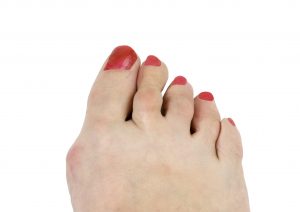 A hammertoe occurs when the joint of a toe is permanently bent, crossed, or pointing at an odd angle. This condition usually occurs after toes have been scrunched up too long, causing the joints to become rigid. Usually the entire foot is affected, as a hammertoe commonly occurs after wearing ill-fitting or narrow shoes for too long.
A hammertoe occurs when the joint of a toe is permanently bent, crossed, or pointing at an odd angle. This condition usually occurs after toes have been scrunched up too long, causing the joints to become rigid. Usually the entire foot is affected, as a hammertoe commonly occurs after wearing ill-fitting or narrow shoes for too long.
Symptoms and Different Types
A hammertoe can occur on any toe, but usually not the big toe. It usually starts with a corn, which can form on the top or tip of the affected toe. There are two different types: flexible and rigid. A flexible hammertoe means the toe can still move to an extent and can usually be treated easily. A rigid hammertoe occurs after the condition has persisted too long and usually must be fixed with surgery.
Why a Hammertoe is No Reason for Woe
A hammertoe is easy to diagnose and usually easy to cure. Make sure to wear shoes that fit properly and are not too narrow but also note that shoes are not the only cause. Diseases like diabetes, arthritis, and other neuromuscular conditions can also be a cause. Foot injuries, like stubbing or breaking your toe, can also result in a hammertoe if correct healing does not occur. That’s why it is important to check your feet on a weekly basis. Early detection will prevent the forming of a rigid hammertoe that could require surgery to cure.
Casteel Foot & Ankle Center
Casteel Foot & Ankle Center is a podiatry office highly trained in foot & ankle surgeries. Our team will provide assistance to any patient, whether you’re facing a simple condition or a severe injury. If you are experiencing symptoms of a hammertoe condition or are interested in knowing more about our clinic, schedule an appointment with us today.
